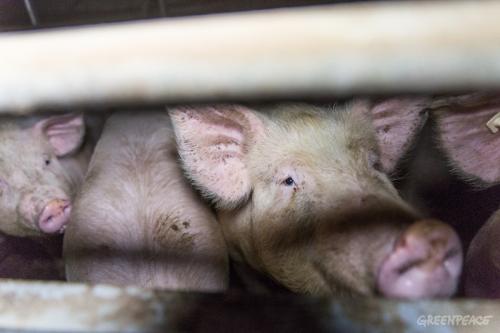Investigation: EU subsidises Europe’s most polluting livestock farms
CAP payments fund factory farms leaking ammonia into air and water
Subsidies from the European Union’s Common Agricultural Policy (CAP) are supporting some of Europe’s most polluting livestock farms, a Greenpeace investigation has revealed.

Over half (51%) of the farms examined in seven EU countries received CAP payments totalling €104 million in the last year reported, despite being the highest emitters of ammonia in their countries. The research compared CAP direct payments and the EU’s registers of pollution from industrial facilities.
Ammonia runoff from fertilizers or manure slurry leads to the rapid growth of algae in rivers, lakes and seas, choking plants and animals of oxygen. Ammonia also causes air pollution from fine particulate matter, which impacts human health.
Marco Contiero, Greenpeace EU agriculture policy director, said: “Environmental protection is one of the objectives of Europe’s farm policy, but the evidence shows that bad behaviour is constantly rewarded. Ammonia pollution is just the tip of the iceberg. Europe continues to pump cash into livestock factory farms despite their disastrous impact on the local environment, the climate and public health. The EU’s Common Agricultural Policy must instead support agriculture that works with nature, not against it.”
The research, which was carried out in collaboration with investigative journalists, examined farms in Belgium, Denmark, France, Germany, Italy, Poland and the Netherlands listed in the European Pollutant Release and Transfer Register (E-PRTR). Agricultural installations are required to submit data to the E-PRTR if they emit more than 10,000 kg of ammonia per year, and to the Industrial Emission Directive register if they have space for over 40,000 poultry, 2,000 pigs or 750 sows.
Of the 2,374 livestock farms in these countries emitting high enough levels of ammonia to be included in the European Pollutant Release and Transfer Register in the last year reported, 1,209 received CAP payments totalling at least €104 million per year. The CAP annually allocates €59 billion in subsidies, roughly 40 per cent of the EU’s total budget.
The research also exposed the lack of a proper monitoring system to provide data on agricultural pollution in Europe. For ammonia, the only pollutant consistently reported at EU level, existing data covers only a small percentage of total emissions from agriculture. Farms in Austria in the Industrial Emissions Directive register were also examined, but none individually met the ammonia threshold to be included in the E-PRTR, despite high levels of ammonia emissions in the country. 36 of these farms received €1.6 million in CAP payments.
Next steps for CAP
On 2 May, the European Commission is expected to publish a draft of the next EU budget, starting in 2020, which will include CAP spending. By early June, the Commission is also expected to publish its proposal for a reform of the CAP.
Source: Greenpeace European Unit
- 326 reads
Human Rights
Fostering a More Humane World: The 28th Eurasian Economic Summi

Conscience, Hope, and Action: Keys to Global Peace and Sustainability

Ringing FOWPAL’s Peace Bell for the World:Nobel Peace Prize Laureates’ Visions and Actions

Protecting the World’s Cultural Diversity for a Sustainable Future

Puppet Show I International Friendship Day 2020

